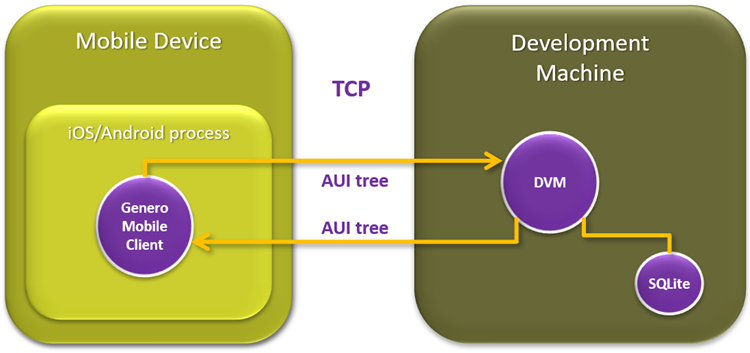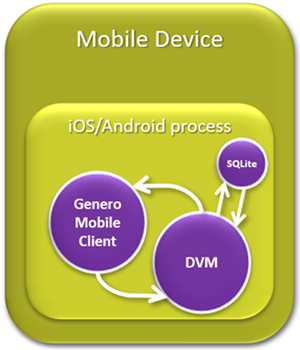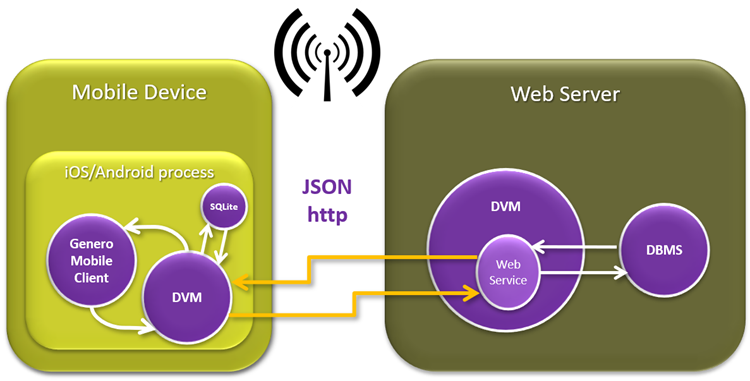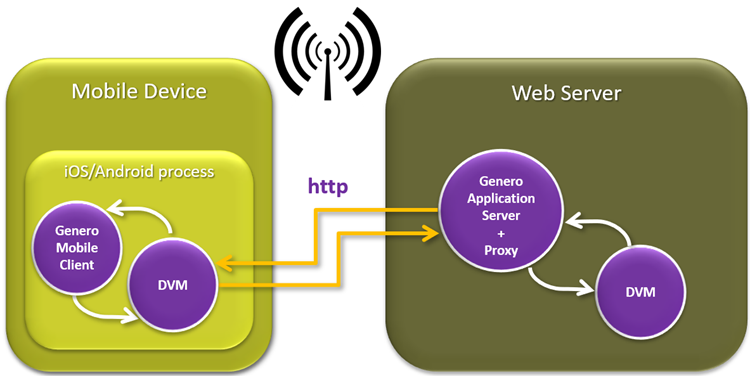Types of Genero Mobile apps
Genero supports different types of mobile app architectures: development mode, standalone apps, partially-connected apps, and client-server apps.
When you are developing your app, and you execute the app on your development machine for display on a device or emulator, you are running the app in development mode.
When you follow the procedure to deploy your application to the device for testing or to distribute your app to your end users, you have a deployed app. This type of app is also referred to as an embedded app, as it has a DVM embedded in the app that runs on the mobile device. A deployed app might be an app that executes irrespective of network availability; it might be an app that accesses device peripherals; it might be an app that requires network access.
Development mode
In development mode, the app process is running on a server, and the forms are displayed on a mobile front-end.
This architecture is typically used when developing your application, as you can easily modify, recompile and execute your sources on the development machine, without the need to deploy the app on the device.

Standalone apps
A standalone app has the DVM and display client entirely on the mobile device. This app executes irrespective of network availability and can access device peripherals such as the camera, contacts, email, calendar, GPS, and storage via exposed APIs (front calls). For database needs, this app can only connect to a local SQLite database.

Partially-connected apps
A partially-connected app has the DVM and display client entirely on the mobile device, yet this app includes items that require a network connection. This app must be able to run when no network connection is available. This app uses a network API to talk to any back-end.
- Web Services performed with JSON over HTTP; use RESTful methods to write data synchronization
routines. With this example, business logic executes within the device's Virtual Machine and the
user is able to store captured data to a local SQLite database. When the network becomes available,
the user synchronizes the stored data with the remote server’s database.Note: As of Genero Mobile 1.1, you can also write a Web Service using SOAP.
- A web component that runs Google Maps.
This app first operates without a network connection, and must be able to run without a network connection. Once network connectivity is restored, the app can perform network-dependent tasks such as synchronizing with a remote database, make a web service call, or use a web component.
If you are using GMI, and the device goes into standby mode, the application does not run in the background and activities with the network are suspended.

Client-server apps
With a client-server app or connected app, the bulk of the app runs on a remote server and the display client sits on the mobile device.
As with any deployed app, this app first starts on the mobile device; the DVM for the deployed
app runs on the mobile device. The role of the deployed app, however, is to connect to a remote
corporate server as an online terminal. It is the deployed app that launches the remote application
using the runOnServer frontcall. The remote application's DVM and business logic
reside on the remote server, somewhere in the network. The remote application is not limited to a
SQLite database.
In the event that the network is interrupted, the Genero Mobile client app is suspended until service resumes.

Licensing considerations
- Development mode needs a development license.
- Partially-connected app consumes a Genero runtime license when the app connects to the Web service to synchronize with the network database.
- Client-server app consumes a Genero runtime license on the Genero Application Server.
For specific mobile app license details, see your Software License Agreement, or contact your nearest Four Js sales office.